Pastor’s Word

Sabbath Keeping
by Rev. Racquel Ray
Associate Minister of Congregational Life
The book of Genesis 2:2-3 reads, “And on the seventh day God ended God’s work which God had done, and God rested on the seventh day from all God’s work which God had done. Then God blessed the seventh day and sanctified it, because in it God rested from all God’s work which God had created and made.” Beloved, even God rests!
In the past few weeks, I have been deeply reminded to return to a praxis of Sabbath Keeping. I have been over scheduled with meetings, events, appointments, and obligations. Add to the schedule that it is May – a time for my children’s schools to add end-of-year concerts, field trips, meetings, and special days. And, May and June are also a busy time at church as the program year winds down with Jubilation, Baccalaureate, Annual Meeting, and end-of-year reports. In addition, I helped the Town of Barrington with the Memorial Day Observances and the Barrington PRIDE event and helped organize the SNEUCC Clergy Wellness Day. Needless to say, the Scripture from Genesis has been screaming loudly in my head. I feel the Holy Spirit saying, “Racquel, remember to rest.”
 I know I’m not alone. Every parent of school-aged kids I’ve talked to over the past few weeks is experiencing the same overwhelm. I have seen many of our church members at the Choralpalooza, High School Orientation, Boy Scouts and Girl Scouts graduation ceremonies, and at the parades.
I know I’m not alone. Every parent of school-aged kids I’ve talked to over the past few weeks is experiencing the same overwhelm. I have seen many of our church members at the Choralpalooza, High School Orientation, Boy Scouts and Girl Scouts graduation ceremonies, and at the parades.
In the middle of the cold and cloudy dark days of winter, I scheduled our family summer vacations! We are planning on two separate trips; one in June and one in August to bookend our summer time together as a family. It is our tradition to go away as soon as school is over and just before it (and the church program year) resumes in late August into early September. I was so relieved when I turned the page in my calendar to June and saw VACATION written in bold letters across the week in June. Knowing that there is a break down the road gives me the freedom to really ‘go for it’ between now and then.
In the meantime, I know I still need moments of respite during the day and during the week. I enjoy – and deeply need – my morning quiet and coffee time at 5am. I enjoy Friday nights with my kiddos watching a scary show, or a super hero movie, or a series. I often indulge in a ‘pastor’s nap’ or a walk around a conservation area on Sunday afternoons.
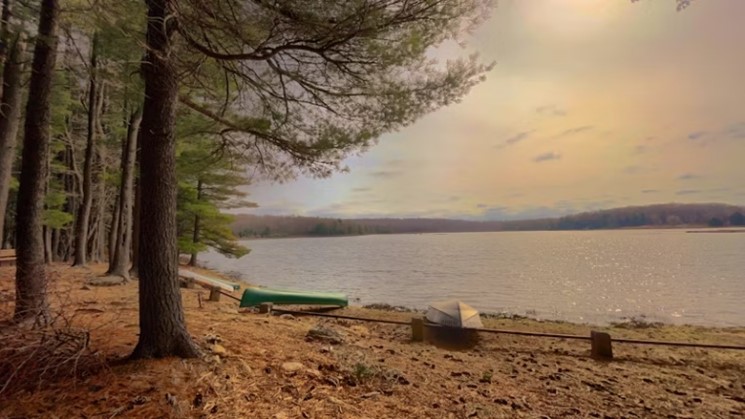 But, yesterday, I added another favorite. I turned off my phone – and all of its notifications – and went to the beach. There is something about the wind and the waves that drowns out inner dialogue and calms the mind, body, and spirit. And, I read a book that has been on my reading list that has nothing to do with liturgy, sacraments, church, ministry, or service. And I was able to catch some deep diaphragmatic breaths while breathing in the salt water spray and scent. What a blessing!
But, yesterday, I added another favorite. I turned off my phone – and all of its notifications – and went to the beach. There is something about the wind and the waves that drowns out inner dialogue and calms the mind, body, and spirit. And, I read a book that has been on my reading list that has nothing to do with liturgy, sacraments, church, ministry, or service. And I was able to catch some deep diaphragmatic breaths while breathing in the salt water spray and scent. What a blessing!
Luke 4:16 reads, “So He came to Nazareth, where He had been brought up. And as His custom was, He went into the synagogue on the Sabbath day, and stood up to read.” Jesus kept the Sabbath. He also had a praxis of going away from the crowds and his followers to pray, to worship, to be alone in the wilderness.
Beloved, let this be a reminder to us all. REST. Take a moment wherever you find yourself in life’s journey and schedule just to keep a sabbath. It will look different for each of us and we can learn from each other but ‘just do it’. Remember to keep a sabbath.
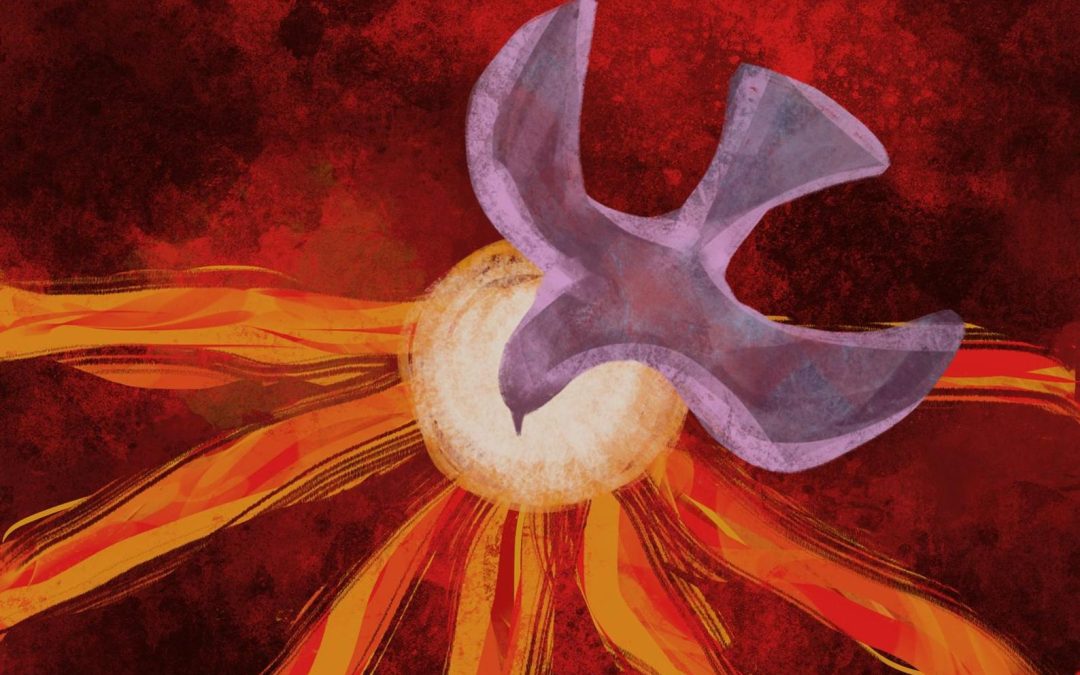
The Neglected Stepchild
by Rev. Dr. Dale Azevedo, Sr. Minister
Stories have abounded for ages (Cinderella, anyone?) about children who have been neglected by their stepparents. Fortunately, recent research at East Carolina University (ECU) has shown that this fairy-tale trope isn’t particularly accurate.1 Sadly though, ECU’s research comes a little too late for poor old Pentecost.
You’ve heard of Pentecost, haven’t you? The oft-neglected stepsibling of Christmas and Easter? You wouldn’t know it by strolling through the department store aisles or listening to the radio or television, but Pentecost, along with Christmas and Easter, is one of the three holiest seasons in the Christian year. You’d never imagine going a year without Christmas, would you? Or skipping the celebration of Easter? But when was the last time you sent someone a Pentecost card? Or hid a basket of gifts for the kids on Pentecost? Not only that, but Christmas gets 12 DAYS to celebrate it. And Easter gets 7 WEEKS! But poor old Pentecost only gets one day, one day that we often forget because this time of year is just too busy.
Do you even know when Pentecost is celebrated this year? Or what it commemorates?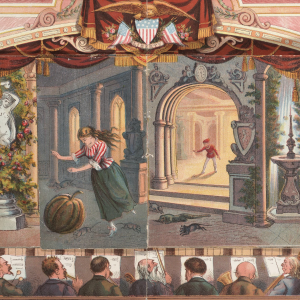
Sadly, while Christmas and Easter get to go to the “Hallmark” ball, shunned little Pentecost gets stuck sitting at home cleaning out the fireplace.
So, this year we are throwing a ball just for Pentecost!
This year, Pentecost falls on Sunday, May 19. Yes, that’s THIS Sunday! And, of course, we have other plans set for worship. This Sunday is Jubilation Sunday, the celebration of the end of our church school year. It is a big day for our church and a chance to celebrate our children, their growing faith, their leadership, and all the hard work of our church school volunteers and staff. So, once again, Pentecost was relegated and set aside on a busy day.
That’s why I have decided to declare Sunday, May 26, as Pentecost: Part Deux! On that Sunday, we are going to give Pentecost all the accolades and appreciation it is due. All of our hymns…Pentecost. All of our prayers…Pentecost. All of our readings…Pentecost. And our sermon…you guessed it…Pentecost!
So, to get ready to show Pentecost the appreciation it deserves, I’m going to share with you a little bit about this oft-neglected beauty.
1. 50th Day – That what Pentecost means. It means the 50th day following Passover. It comes from the Jewish tradition of the Feast of Weeks (i.e. a week of weeks, or 49 days, following Passover). The end of the Feast of weeks was called Pentecost. As you see below, something special happened on the 50th day after Passover on the year Jesus was killed.
 2. Red – The liturgical color of Pentecost is Red. It is relatively unique for this day. Some traditions will also use red on Palm Sunday and others on Good Friday, but all churches that follow the liturgical calendar use red on Pentecost. All other high holy days use white. While some others seasons commonly use green purple or blue, red is held back for Pentecost (except as noted above). Other symbols used on Pentecost are a flame or a dove. Both symbolize the Holy Spirit (see below!).
2. Red – The liturgical color of Pentecost is Red. It is relatively unique for this day. Some traditions will also use red on Palm Sunday and others on Good Friday, but all churches that follow the liturgical calendar use red on Pentecost. All other high holy days use white. While some others seasons commonly use green purple or blue, red is held back for Pentecost (except as noted above). Other symbols used on Pentecost are a flame or a dove. Both symbolize the Holy Spirit (see below!).
3. Holy Spirit – Pentecost is a celebration of the Holy Spirit. It was on Pentecost that the Holy Spirit descended upon, and overwhelmed, the disciples and everyone else who had gathered in Jerusalem for the Feast of Weeks in the year of Jesus death. You will hear this story when you come to church on May 26th!
4. Happy Birthday – Pentecost is treated as the birthday of the church. It was the giving of the Holy Spirit to the disciples and followers of Jesus that we recognize as the beginning of the church. This is when the mantle of sharing the faith passed from Jesus to his followers.
So, there you have it. Pentecost in a nutshell. Now you can come to church on May 26th, ready to party and let Pentecost know how beloved it is!
See you then!
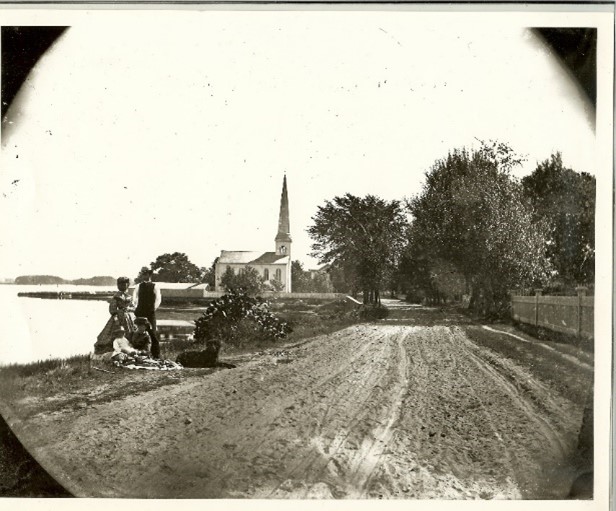
A Spirit of Change
by Rev. Racquel Ray
Associate Minister of Congregational Life
Are you the type of person who has kept their living room arranged the same way for decades? Or are you the type of person who rearranges and rotates regularly to keep things fresh?
This week, I’m reminded of Paul’s letter to Timothy, “God did not give us a spirit of cowardice but rather a spirit of power and of love and of self-discipline.” In some versions, the spirit of cowardice is translated as a spirit of fear. As we live into this post-pandemic, election, and church restructure year, I have heard rumblings of an undercurrent of fear. I even have some of my own!
Fear often prevents us from taking action. Fear of the unknown often hinders our ability to change. We can become consumed with internal ‘what if’ dialogues! What if (insert new thing here) causes us to (insert fear here) and everything is (insert catastrophic result here)?!
 Often, turning to scripture or Spiritual self-help is no help either. If you just have faith the size of a mustard seed everything will be ok. If you have the faith of a child everything will be ok. If you believe in God or Jesus or your church or it’s leadership enough, everything will be ok. And sometimes, everything will be ok. And sometimes, it won’t. The problem with over Spiritualizing our situation is that we can often blame ourselves, our loved ones, our church, our church leadership, or God when things don’t turn out as we planned.
Often, turning to scripture or Spiritual self-help is no help either. If you just have faith the size of a mustard seed everything will be ok. If you have the faith of a child everything will be ok. If you believe in God or Jesus or your church or it’s leadership enough, everything will be ok. And sometimes, everything will be ok. And sometimes, it won’t. The problem with over Spiritualizing our situation is that we can often blame ourselves, our loved ones, our church, our church leadership, or God when things don’t turn out as we planned.
So, how do we live into change? And in a church context, how do we live into change in the face of fear and in a Spiritual way? Our Quaker siblings have a wisdom to share in this area; we could pray and then wait for the answer. How can we apply this principle in our current changing context?
 We can read the rest of Paul’s letter to Timothy, “I am grateful to God—whom I worship with a clear conscience, as my ancestors did—when I remember you constantly in my prayers night and day…I am reminded of your sincere faith, a faith that lived first in your grandmother Lois and your mother Eunice and now, I am sure, lives in you. For this reason, I remind you to rekindle the gift of God that is within you through the laying on of my hands, for God did not give us a Spirit of fear…”
We can read the rest of Paul’s letter to Timothy, “I am grateful to God—whom I worship with a clear conscience, as my ancestors did—when I remember you constantly in my prayers night and day…I am reminded of your sincere faith, a faith that lived first in your grandmother Lois and your mother Eunice and now, I am sure, lives in you. For this reason, I remind you to rekindle the gift of God that is within you through the laying on of my hands, for God did not give us a Spirit of fear…”
Beloved, this church has seen its share of change. In a few hundred years, this church has weathered many storms. It has been broken and flooded. It has been divided and rebuilt. But, I have no doubt that the Spirit of God that resides in this congregation and in each of you empowers us with a boldness that can only be from God. This Spirit is witnessed in your ministry and in your ‘spirit of power and of love and of self-discipline.’
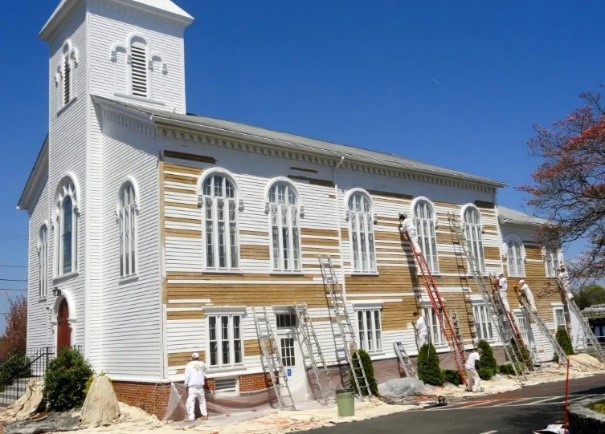 Each visitor that is embraced, each child that is nurtured, each elder that is supported, and each minister that is raised here has witnessed your spirit of power, love, and self-discipline!
Each visitor that is embraced, each child that is nurtured, each elder that is supported, and each minister that is raised here has witnessed your spirit of power, love, and self-discipline!
As we grow into the new structure – and with it some challenging conversations and difficult decisions – let us remember that we do not need to come to these moments with a spirit of fear. We can work through our changes, pray through our changes, and wait through our changes as our ancestors have done. We too can approach these conversations and decisions with the Spirit of power which equips us to embrace the prophetic and bravely transition into the unknown future. We can move forward with a Spirit of love that opens our egos and our humility to make space for being wrong. We can hold our opinions and sometimes our tongues allowing self-discipline to pull us back from saying hurtful or harmful things.
 Change can be hard. And the church is changing. Therefore, sometimes church can be hard. Do we leave? Do we quit? Do we freeze from fear? Or, do we prayerfully, powerfully, and prophetically move forward in love and leave behind our fear? Let us ‘rekindle the gift of God that is within you’ – that same faith that lives in you, in your parents, and in your grandparents – and in the ancestors of this church – and traverse these changes together.
Change can be hard. And the church is changing. Therefore, sometimes church can be hard. Do we leave? Do we quit? Do we freeze from fear? Or, do we prayerfully, powerfully, and prophetically move forward in love and leave behind our fear? Let us ‘rekindle the gift of God that is within you’ – that same faith that lives in you, in your parents, and in your grandparents – and in the ancestors of this church – and traverse these changes together.
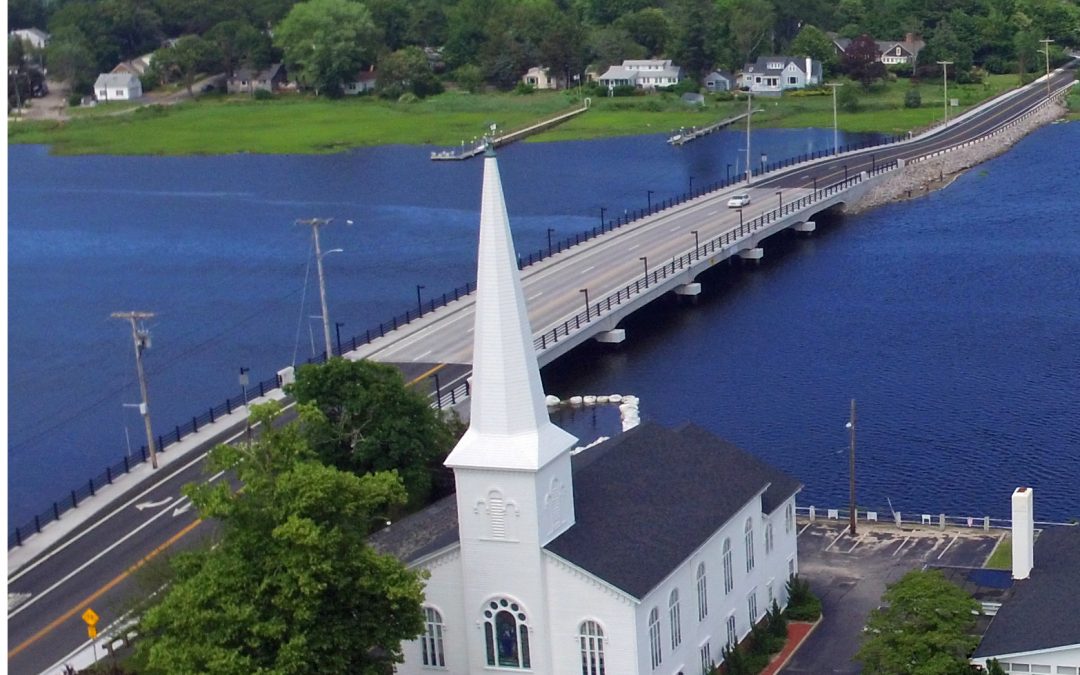
Why do you come to church?
by Rev. Dr. Dale Azevedo, Sr. Minister
Those of you who have been attending worship at BCCUCC since before the pandemic may remember the Sunday when I asked everyone to get up and change seats. That morning, I divided the pews into four sections and labeled each section according to a part of our mission Statement. The sections were divided as follows:
South: Worships God
South-central: Cares for One Another
North-central: Works for Justice and Peace (this was combined with Welcomes All)
North: Renders Loving Service
I asked everyone to get up and sit themselves in the section that best represented the main reason they chose to participate in BCCUCC.
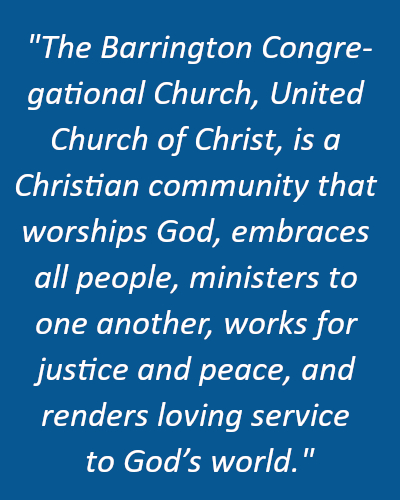 What surprised us all was that all four sections ended up roughly equal in occupants. No one expected such a well-rounded representation of our mission statement among our members.
What surprised us all was that all four sections ended up roughly equal in occupants. No one expected such a well-rounded representation of our mission statement among our members.
Some of us attend BCCUCC to worship.
Some of us attend to be a part of a community.
Some of us attend to witness for social justice.
Some of us attend to help others in need.
And all of us do this as a part of our relationship with, and commitment to, God.
So, I ask you, “Why do you participate in BCCUCC?” If you had to answer that question for yourself, and place yourself in one of those four categories, which one would you choose? And…once you know that, how are you living out that reason? What are you doing to live into that focus of your calling? Would you feel more fulfilled or would your relationship with church be more meaningful if you were doing more? Or something different than you currently are?
When we adopted our new church structure, we also divided our ministries into these categories; not just the four I used years ago, but six (five from our mission statement plus faith formation). And we have numerous teams each focused on a particular ministry belonging to one of these categories. For example, under faith formation we have teams that  focus on church school, adult education, the nursery, and confirmation (among others). The idea in this new format is to provide people easy entry into a small, focused ministry that they are interested in. If you want to focus on worship, join one of our worship teams. If you want to focus on helping those in need, join one of our service teams. The choices are endless. (This is literally true because if we don’t have a team for you already, you can always start a new one!)
focus on church school, adult education, the nursery, and confirmation (among others). The idea in this new format is to provide people easy entry into a small, focused ministry that they are interested in. If you want to focus on worship, join one of our worship teams. If you want to focus on helping those in need, join one of our service teams. The choices are endless. (This is literally true because if we don’t have a team for you already, you can always start a new one!)
“But, Dale,” you ask, “how do I know what teams already exist? And how do I get involved?”
Well, I’m glad you asked! All our ministry teams are now listed on the website by category along with contact information for the team leader. You can simply reach out to the team leader and share your interest. Or, if that is a little intimidating, you can also reach out to Racquel or me and ask for help. We will gladly introduce you to someone who can help bring you along.
While we’re talking about this, I should also say a little something about our support teams. Support teams are those  teams that do not fit directly into our mission statement but are essential to running our church and therefore are the foundation our primary ministry teams need to be successful. These teams are focused on property, finance, and administration. These teams are great for people who like doing, who like working behind the scenes, and who often have special skills like understanding numbers, working on physical projects, or helping with human resources. Not all these teams require these special skills, many just require a willingness to be a part of a decision-making process. But they sometimes appeal to a type of person who may feel called to get involved in a way different from one of our primary teams. If this is you, you are needed too!!
teams that do not fit directly into our mission statement but are essential to running our church and therefore are the foundation our primary ministry teams need to be successful. These teams are focused on property, finance, and administration. These teams are great for people who like doing, who like working behind the scenes, and who often have special skills like understanding numbers, working on physical projects, or helping with human resources. Not all these teams require these special skills, many just require a willingness to be a part of a decision-making process. But they sometimes appeal to a type of person who may feel called to get involved in a way different from one of our primary teams. If this is you, you are needed too!!
So, take a moment and think about why you have chosen to be a part of our church community. And then explore our ministry team list and see if there is a ministry you are interested in being a part of. It can make your participation in BCCUCC even more rewarding!!
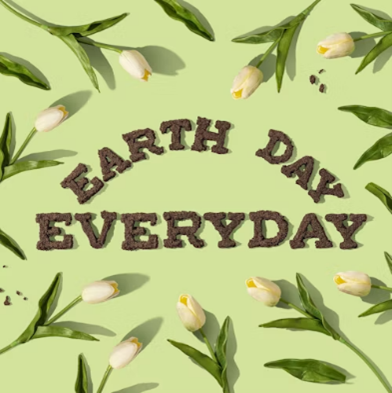
Earth Day
by Rev. Racquel Ray
Associate Minister of Congregational Life
In the days of Noah, God promised, “I will never again curse the ground because of humankind…as long as the earth endures, seedtime and harvest, cold and heat, summer and winter, day and night, shall not cease.” (Genesis 8:21-22). However, changes are happening to the earth which do threaten human flourishing. Ice caps are melting, oceans are warming, wildlife is changing, and natural disasters all effect how we live. What are your thoughts on climate change and humanity’s impact on the climate? How does climate impact humanity?
Earth Day is April 22nd. Originally celebrated in 1970, Earth Day is now an annual event celebrating, observing, and motivating environmental justice. By extension, some have dedicated April as Earth Month or Creation Care Month. How we observe Creation Care Month can be a reflection of our personal theology around stewardship of the planet. For some, creation stewardship draws them to Climate Change rallies on the statehouse lawn. For some, creation stewardship means shopping small and local or using refillable beverage containers. What can you do to be a good creation care steward?
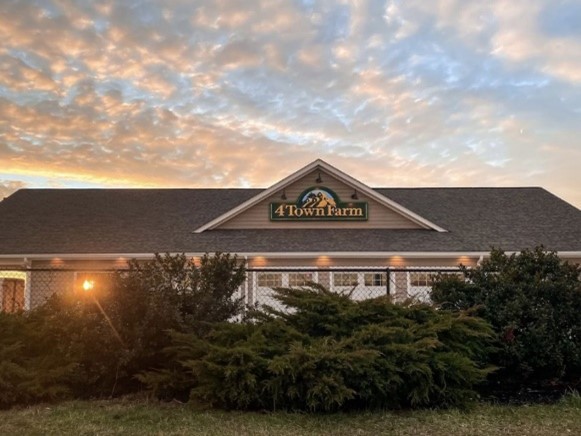 When my oldest children were small, our family had a goal of reducing our carbon footprint. We lived in a walkable city with a local food co-op, weekly farmer’s market, and several parks and museums with outdoor green space. The power bill was offset with clean energy generated through hydro-electric credits. We could shop locally and bring reusable totes and refillable containers to the co-op. We could use environmentally safe soap and detergent and add ‘grey’ water (from bath, dishes, or laundry) to the arid soil to keep the garden watered and pest free. We challenged the kids to conservation contests by seeing who could use the least water in a shower – closing the drain and measuring how many inches of water were left in the tub.
When my oldest children were small, our family had a goal of reducing our carbon footprint. We lived in a walkable city with a local food co-op, weekly farmer’s market, and several parks and museums with outdoor green space. The power bill was offset with clean energy generated through hydro-electric credits. We could shop locally and bring reusable totes and refillable containers to the co-op. We could use environmentally safe soap and detergent and add ‘grey’ water (from bath, dishes, or laundry) to the arid soil to keep the garden watered and pest free. We challenged the kids to conservation contests by seeing who could use the least water in a shower – closing the drain and measuring how many inches of water were left in the tub.
Barrington has many ‘green’ attributes. We have the East Bay Bike Path, the Barrington Farm School, Land Conservation Trust green spaces, the town beach, and several parks and playgrounds all open to the public. The local food and farm to table food systems are growing. Recycling and composting are becoming more common. We’re adding sidewalks and small businesses. And our local farms and markets provide a decent variety of local, in season produce and locally made products. What are some of your favorite local ‘green’ spots?
 Our family has settled and put down roots, figuratively and actually, by creating Ray Farm. Our yard is a wholistic suburban yard farm which provides year-round organically grown food for our family. We are a National Wildlife Federation certified habitat. We grow blueberries, blackberries, black raspberries, golden raspberries, cherries, pears, apples, kale, carrots, asparagus, rhubarb, cucumbers, green beans, tomatoes, potatoes, peppers, and herbs. We added solar panels in 2023 and upgraded to electric heat as well. We have not been able to eliminate our carbon footprint – but we sure have reduced it! How do you reduce your carbon footprint?
Our family has settled and put down roots, figuratively and actually, by creating Ray Farm. Our yard is a wholistic suburban yard farm which provides year-round organically grown food for our family. We are a National Wildlife Federation certified habitat. We grow blueberries, blackberries, black raspberries, golden raspberries, cherries, pears, apples, kale, carrots, asparagus, rhubarb, cucumbers, green beans, tomatoes, potatoes, peppers, and herbs. We added solar panels in 2023 and upgraded to electric heat as well. We have not been able to eliminate our carbon footprint – but we sure have reduced it! How do you reduce your carbon footprint?
Whether you plow under your lawn to grow food, recycle your discarded clothes and fabrics in the collection shed in the church parking lot, add solar power to your home, turn off the water while brushing your teeth, upgrade to efficient appliances, or simply refill your reusable water bottle you can make a difference. Each of us are created to ‘tend and to till’ this earth – as God instructed humanity through Adam and Eve. What’s your ‘green’ practice?
This month, chose one thing you can do to make a difference. Will you drive less? Turn off lights in empty rooms? Hang your laundry to dry outside? Have Meatless Meal Monday? Shop locally? Support a local farm? Learn about composting? Plant a garden? Reduce the amount of plastic you use? Plant a tree?
 Come celebrate Creation Care Sunday on April 21st and bring your own mug (or use one of ours) for coffee hour. Also, bring your own Creation Care ideas to share during the worship service and during the fellowship time afterwards at coffee (which is always fair trade and equal exchange). Let’s grow green together!
Come celebrate Creation Care Sunday on April 21st and bring your own mug (or use one of ours) for coffee hour. Also, bring your own Creation Care ideas to share during the worship service and during the fellowship time afterwards at coffee (which is always fair trade and equal exchange). Let’s grow green together!
- Barrington Land Conservation Trust, Clean-up Allin’s Cove Conservation Area. Sunday, April 21, from 1 to 3 pm to help us clean up litter as well as debris that has washed ashore over the winter. All ages are welcome with parental supervision. https://www.blct.org/earth-day-eve-cleanup-at-allins-cove/
- Eastern Rhode Island Conservation District Earth Month events include seedling sales, plogging (picking up litter while jogging), and rain barrel workshops https://www.easternriconservation.org/earthmonth
- Four Town Farm opening mid-April https://4townfarm.com/
- Plant City X opening soon in Barrington Center https://plantcityx.com/
- Prickly Ed’s Cactus Patch Native Plant Emporium, Reopening “Earth Week” April 2024! https://pricklyeds.com/

What is your favorite hymn?
by Rev. Dr. Dale Azevedo, Sr. Minister
If the stories I was told in seminary were true, then in the late 1980’s the United Methodist Church conducted a survey of its membership to determine which hymn in its new hymnal was the most beloved and which was the most disliked. The results of this survey were hilarious and “How Great Thou Art” was rated BOTH the most beloved and the most disliked. Apparently, because so many people liked the hymn it was often sung at funerals. And because it was so often sung at funerals, other people disliked it or had negative connotations associated with it. What do you think of “How Great Thou Art?” Personally, I like it!
However, I would probably not classify it as one of my favorites.
I have numerous hymns that I like. Some I like because I love the tune that they are paired with. These would be songs like “Now the Green Blade Rises” or “What Child is This?” Others, like “De colores” or “What Wondrous Love is This,” I like because of the words  or the theology they proclaim. Still others hold a special place in my heart because they invoke fond memories or emotions from days long gone. I’m talking about you, “Old Rugged Cross” and “Here I Am, Lord.”
or the theology they proclaim. Still others hold a special place in my heart because they invoke fond memories or emotions from days long gone. I’m talking about you, “Old Rugged Cross” and “Here I Am, Lord.”
What about you? What hymns do you like? What hymns make you smile, or cause you to tear up? What hymns transport you to another time or place? What hymn do you wish we sang more often, and why?
We have a special opportunity coming up to explore these questions and hear the answers from one another. As many of you may recall, Racquel tore up her knee quite badly last summer. Surgery wasn’t needed immediately, but it was recommended once her leg had some time to heal from the initial trauma. That surgery has been scheduled for April 4th, the Thursday after Easter. As it turns out, Racquel was scheduled to preach on April 7th. When we realized this, we decided that alternate plans needed to be made. So, we are planning a new experience:
We’re going to have a hymn sing!
 But this is not going to be just like any other hymn sing. We are going to sing your favorites and learn why they mean so much to you!
But this is not going to be just like any other hymn sing. We are going to sing your favorites and learn why they mean so much to you!
Between now and April 7th, I am inviting everyone who wants to, to pick out one of your favorite hymns that you would like to share that Sunday. You will be given the choice to announce which hymn you have chosen and share briefly about why it is so meaningful to you. As you see from what I shared above, there can be any number of reasons why that hymn may be so meaningful. Your reason doesn’t need to be revolutionary or entirely profound. It means something to you, and that is good enough for us. Maybe your grandmother used to sing it to you, or maybe it was played at your wedding, or maybe it spoke to you at a turning point in your life. Who knows? But I invite you to share your story and your hymn with us on the 7th. Then, after you share, we will sing your hymn together as a congregation.
So, do you have a favorite hymn, or one of many favorites? Is there a hymn that holds special meaning in your faith, family, or past? If so, let me know. Not everyone needs to reserve their spot ahead of time, but if you want to make sure you get a chance to share, send me an email or call me up and I’ll make sure we save time for you.
In the meantime, keep on singing!
Oh, and if you like or despise “How Great Thou Art,” that’s okay. Apparently, you aren’t alone!

Just Go For It!
by Rev. Racquel Ray
Associate Minister of Congregational Life
Have you ever had a big idea? I’m talking about a life changing, once in a blue moon, out of this world idea! An idea so great that it would change the course of your life and the lives of your families and friends for future generations. After thinking through all the scenarios and possible outcomes, you were ready to Go For It. And as soon as you told one person, you began to doubt your ability to make your idea become a reality. As soon as you shared your idea, liminal thinking begins to construct its viability.
Often, we not only doubt our own ability to succeed but we also seek and accept others’ opinions of whether or not we can succeed. Even our most well-intentioned loved ones may offer defeatist viewpoints of our potential. How many times have we heard things like, “You don’t have the time for that” or “You can’t do that”? Our responses to these realities can cause us to quit before we even try.
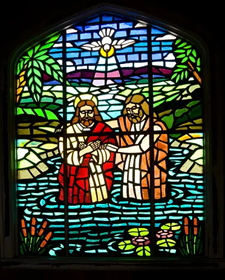 Jesus himself faced many of the same limiting negative comments. When Jesus’ public ministry first began, John first denied the need for Jesus’ baptism by saying John wasn’t worthy to do what Jesus asked him. Jesus was then led to the desert by the devil according to Luke’s account where Jesus authority was questioned and tempted. And, after Jesus first opened the scroll in the synagogue and read from the prophet Isaiah, the people questioned his upbringing and were filled with rage!
Jesus himself faced many of the same limiting negative comments. When Jesus’ public ministry first began, John first denied the need for Jesus’ baptism by saying John wasn’t worthy to do what Jesus asked him. Jesus was then led to the desert by the devil according to Luke’s account where Jesus authority was questioned and tempted. And, after Jesus first opened the scroll in the synagogue and read from the prophet Isaiah, the people questioned his upbringing and were filled with rage!
Often when we have a big idea we too face these questions and temptations. Our supporters may not feel they have the skills to help. We may be tempted with illusions of grandeur such as power, wealth, fame as Jesus’ was in the desert. Or we may face doubt and anger from our closest loved ones. A big idea needs to be nourished by a growth mindset, a positive attitude, and some strong boundaries (and thick skin) to keep the negative at bay.
 When we approach our big idea potential with a growth mindset we are aware of those potential negative opinions and are prepared to deflect with possibility outcomes. When we shift our mindset from defeated to possible, we begin to approach big ideas differently. A new term for this is called liminal thinking. Author Dave Gray defines liminal thinking as a “boundary, doorway, portal…not this or that, not the old way or the new ways, but neither and both.”[1] He says, liminal thinking is “A state of ambiguity or disorientation that precedes a breakthrough to a new kind of thinking. The space between. Liminal thinking is a kind of psychological agility that enables you to success- fully navigate these times of transition. It involves the ability to read your own beliefs and needs; the ability to read others’ beliefs and needs; and the habit of continually evaluating, validating, and changing beliefs in order to better meet needs.”[2]
When we approach our big idea potential with a growth mindset we are aware of those potential negative opinions and are prepared to deflect with possibility outcomes. When we shift our mindset from defeated to possible, we begin to approach big ideas differently. A new term for this is called liminal thinking. Author Dave Gray defines liminal thinking as a “boundary, doorway, portal…not this or that, not the old way or the new ways, but neither and both.”[1] He says, liminal thinking is “A state of ambiguity or disorientation that precedes a breakthrough to a new kind of thinking. The space between. Liminal thinking is a kind of psychological agility that enables you to success- fully navigate these times of transition. It involves the ability to read your own beliefs and needs; the ability to read others’ beliefs and needs; and the habit of continually evaluating, validating, and changing beliefs in order to better meet needs.”[2]
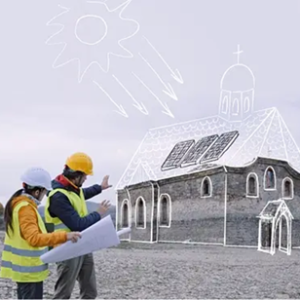 What does liminal thinking and a growth mindset have to do with church? Church is changing. And our church is no exception. If we begin addressing the challenges we face with a defeated before we begin attitude, we’ve already lost – as many other churches are experiencing. Many churches would rather close than change. But, if we approach our challenges with a growth mindset and liminal thinking we can move ahead.
What does liminal thinking and a growth mindset have to do with church? Church is changing. And our church is no exception. If we begin addressing the challenges we face with a defeated before we begin attitude, we’ve already lost – as many other churches are experiencing. Many churches would rather close than change. But, if we approach our challenges with a growth mindset and liminal thinking we can move ahead.
This requires a sense of humility as well because change and growth come with the risk of making mistakes – publicly. We need to be willing to ‘fail forward’. And this requires a willingness to be imperfect and vulnerable.
As we try new things in our church life we face many limiting comments which we’ve all heard and said. The ‘way it’s always been done’ or ‘that’s so and so’s job’ no longer serve us. When one of us is willing to try something new they are trying to Go For It and they are willing to Fail Forward publicly. Whether it’s a new ministry, a new program, or a new structure we’re journeying with liminal thinking into growth and change.
 So the next time one of us has a big idea (like building a garden in the sanctuary) lets couch our comments with the concept of liminal thinking. Changing comments from “Dirt is going to get everywhere…” to “The kids are really experiencing a sense of wonder as their hands are grounded in soil.” Or, “Water’s going to leak all over the pews…” to “Water plays in important role in our spiritual history and our current potential.” Or, “Who’s going to pay for this…” to “What resources can we shift toward the work we find valuable?” Then, we can approach growth and change with a liminal thinking mindset, a child-like sense of wonder, and a Go For It attitude!
So the next time one of us has a big idea (like building a garden in the sanctuary) lets couch our comments with the concept of liminal thinking. Changing comments from “Dirt is going to get everywhere…” to “The kids are really experiencing a sense of wonder as their hands are grounded in soil.” Or, “Water’s going to leak all over the pews…” to “Water plays in important role in our spiritual history and our current potential.” Or, “Who’s going to pay for this…” to “What resources can we shift toward the work we find valuable?” Then, we can approach growth and change with a liminal thinking mindset, a child-like sense of wonder, and a Go For It attitude!
[1] (Gray, 2016)
[2] (Gray, 2016)
References:
Gray, D. (2016). Liminal Thinking, Create the change you want . Rosenfeld Media
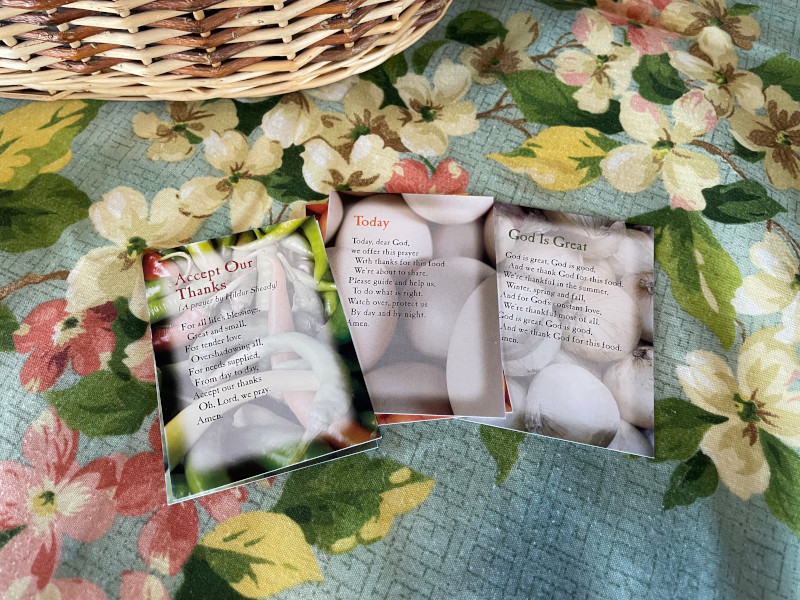
Soup for the Soul
by Rev. Dr. Dale Azevedo, Sr. Minister
“Ask someone at the table a question (any question) and then share with them something you admire or appreciate about them.”
These were the words on the bottom back of the card I drew from the pile at our table. Today was our first Lenten Lunch, and what a wonderful lunch it was!
It was wonderful because the food, company, and conversation were each wonderful.
We had seven delightful hungry bellies at our first Lenten Lunch. The meal consisted of homemade potato and leek soup. Don’t tell anyone it was vegan because it was delicious! In fact, the soup was so 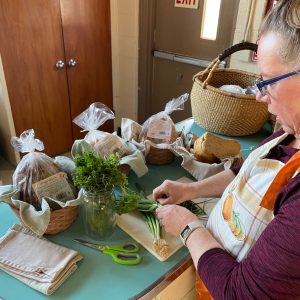 good everyone got up and went for seconds. We also had some nice warm fresh bread to go with our soup. Also don’t tell anyone that I was the first person to dip my bread in the soup. Apparently, it’s impolite! However, when everything is that delicious you can’t help but savor every morsel.
good everyone got up and went for seconds. We also had some nice warm fresh bread to go with our soup. Also don’t tell anyone that I was the first person to dip my bread in the soup. Apparently, it’s impolite! However, when everything is that delicious you can’t help but savor every morsel.
Racquel spent the morning making soup, setting the tables, getting out the “pocket prayer squares,” and setting the tables up all lovely-like. Fellowship hall looked and smelled like a fancy restaurant. We even used real dishes and had sprigs of fresh thyme at each table. When Racquel calls for a Lenten Lunch, she isn’t joking around. When it is my turn in a few weeks, I’ll have a lot to live up to!
Racquel started us off with a traditional Irish prayer. Then we chatted and joked, shared and laughed our way through lunch. When that was over, I grabbed one of the cards from the center of the table and proceeded to follow its instructions (as mentioned above). It was a great way to transition into a slightly deeper level of sharing. Each of us in turn then drew a card and followed the directions it provided, inviting each of us to share a little bit  about our present lives.
about our present lives.
“What is something that you enjoyed recently?”
“What does it mean to be blessed and how have you been blessed recently?”
“What are you looking forward to in the days ahead?”
“What is something that you have experienced lately that was challenging?”
We all took turns reading and sharing and listening. And of course, this sparked us on to further conversation. In the end, I couldn’t have imagined spending my hour and 15 minutes in any better way. It was great to reconnect with church friends, to laugh a little bit in these difficult winter days and enjoy a hearty meal.
15 minutes in any better way. It was great to reconnect with church friends, to laugh a little bit in these difficult winter days and enjoy a hearty meal.
I hope you can make it next week. And if you can’t, maybe you can join us the week after. Racquel and I will be hosting these lunches throughout Lent culminating with our final lunch on Maundy Thursday, March 28. You should really come and join us, we’d love to see you!
You don’t have to, but if you want to RSVP send Racquel an email and let us know you’re coming!
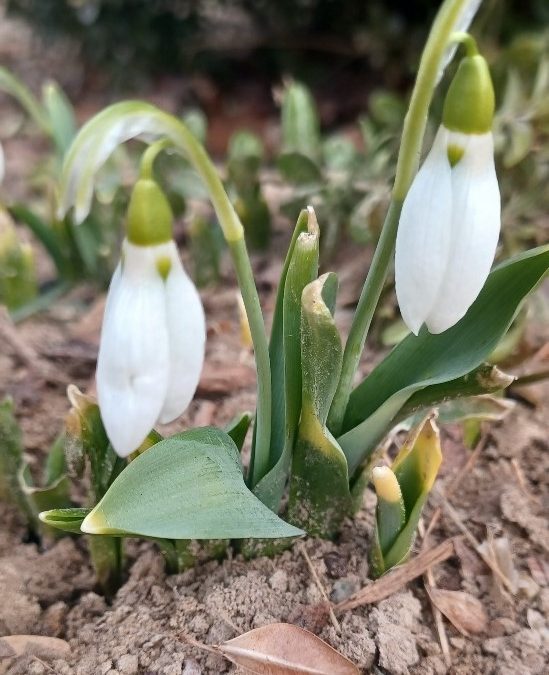
Turning toward the sunshine and the sacred
by Rev. Racquel Ray
Associate Minister of Congregational Life
The Song of the Snowdrop Fairy
by Cicely Mary Barker (1895-1973)
Deep sleeps the Winter, cold, wet and grey:
Surely all the world is dead; Spring is far away.
Wait! The world shall waken: it is not dead, for lo
The Fair Maids of February stand in the snow!
February is here. The month of transitional days begins with the darkness of January and ends with the promise of spring. It was a dreary January. There were too many cloudy days for our solar panels and our psyche to appreciate any solar gain. Seasonal depression was a real challenge for many of us – even those of us for whom this is not usually an issue. I found this Cicely Mary Barker poem comforting and hopeful. Perhaps you do too?
The Song of the Snowdrop Fairy invited me into the garden. It brought me to an observational walkabout around Ray Farm and our church gardens. And, indeed, the Fair Maids of February are standing in the snow (or in this case frozen soil). There are early signs of spring sprouting around the yard and churchyard. For now, we are in a season of hope and preparation.
February is a busy month for my family. We celebrate Lunar New Year with a traditional meal of long noodles, representing a long life. We include orange slices to represent a sweet life and plenty of rice to represent abundant provision. Having served in the military in several Pacific duty stations, our family celebrates with a mix of pan-Asian cuisine. We remember the past and look forward to the coming year.
representing a long life. We include orange slices to represent a sweet life and plenty of rice to represent abundant provision. Having served in the military in several Pacific duty stations, our family celebrates with a mix of pan-Asian cuisine. We remember the past and look forward to the coming year.
We celebrate St. Valentine’s Day and one of our kids’ birthdays. We tap the maple trees in our backyard and spend a week boiling the abundant sap over a wood fire and a specially made stove. Our homemade maple syrup is buttery and smokey; it is rich and dark and very fresh. It is our tradition to celebrate Shrove Tuesday with pancakes smothered in this sweet ichor. Sometimes we’ll 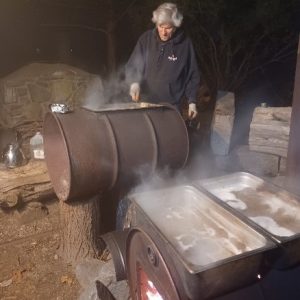 be lucky enough to have johnny cakes or corn meal cakes from last year’s final corn harvest, dried and ground just for this feast. We create a plan for the garden and draw a picture of what will be planted where. And we order the seeds in hopeful expectation of a bountiful autumn harvest.
be lucky enough to have johnny cakes or corn meal cakes from last year’s final corn harvest, dried and ground just for this feast. We create a plan for the garden and draw a picture of what will be planted where. And we order the seeds in hopeful expectation of a bountiful autumn harvest.
In the gardens, the rhubarb is just beginning to break through the mulch. Bright scarlet crowns can be seen among the greys and browns of winter. We’ll soon be harvesting more than we can eat and the overflow will be sliced into bite sized pieces and frozen for later. I usually make a Christmas morning rhubarb crisp many months from now. It often can be enjoyed as pie during coffee hour and potluck meals. The asparagus will be emerging soon and the yard will be dotted with cheery yellow dandelions and deep purple violets. The dandelion roots can be dried and ground and used as a coffee substitute. Our violets are lovingly picked by small hands and made into posies and a delicate light purple spring tonic tea.
Our violets are lovingly picked by small hands and made into posies and a delicate light purple spring tonic tea.
Lent begins on Wednesday, February 14 this year. We as a family and as a congregation will observe the six weeks of preparation before Easter. As the weeks unfold, so will the gardens. Our gardens at home and at church will remind us that new life is imminent.
Pastor Dale and I will be building a garden in the sanctuary throughout Lent. As the weeks pass, our garden will grow and we’ll learn together about the importance of creating sacred spaces; making physical, virtual, temporal, and spiritual places to observe, acknowledge, and celebrate our relationship with God. We’ll learn how to attend 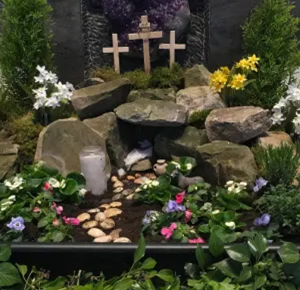 to our prayer lives and nurture our connection with creation and the Creator. We’ll share in Jesus’ praxis of going away to a quiet spot to pray and sometimes it was as simple as ‘a stone’s throw away’ into the garden.
to our prayer lives and nurture our connection with creation and the Creator. We’ll share in Jesus’ praxis of going away to a quiet spot to pray and sometimes it was as simple as ‘a stone’s throw away’ into the garden.
We’ll build a foundational structure and invite the congregation to join us as we add the elements week by week. Soil, representing the nutrient rich foundation where the roots of our faith can take hold and grow deep into the earth. Seeds, representing new ideas co-created and germinated with God to provide for our needs and share with our neighbors. Rocks, representing the cornerstones and building blocks which set boundaries and add structure to our space. Water, representing the power and provision of God which both washes and nourishes us. We’ll add crosses and a tomb to remind us of The Passion and sacrifice of Jesus which makes a way for new life.
As Holy Week and Easter emerge, so will our gardens. The daffodils outside of my church office get an early start in a sheltered corner and are a harbinger of spring to come.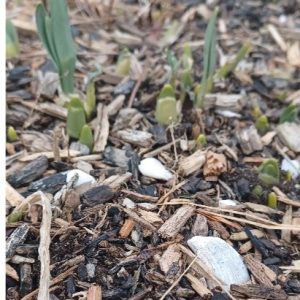 Around the church campus, other clumps of cheerful daffodils, lovingly planted and cared for, will join them in the coming weeks. The pale purple crocus near the labyrinth will blossom. The trees will bud, the forsythia near the kitchen steps will burst with sunny yellow blooms, the pollinator garden will begin to flourish, and our rose hedge will swell with rich greens and coming buds.
Around the church campus, other clumps of cheerful daffodils, lovingly planted and cared for, will join them in the coming weeks. The pale purple crocus near the labyrinth will blossom. The trees will bud, the forsythia near the kitchen steps will burst with sunny yellow blooms, the pollinator garden will begin to flourish, and our rose hedge will swell with rich greens and coming buds.
Where will you find yourself in the coming weeks? Emerging from the dreary grey days of January? Awakening from the frosty hardness of winter? Turning toward the sunshine and the sacred? Looking forward to spring and resurrection? Join us and the snowdrops, the Fair Maids of February, in the journey to new life and new growth in the coming weeks.

A Team for Every Member and Every Member on a Team
by Rev. Dr. Dale Azevedo, Sr. Minister
Last October, we approved our new church structure in principle. This Sunday we will be voting on our new by-laws and (hopefully) moving to our new structure in practice. This will be a fluid transition that we hope will lead to ministries that are more flexible, relevant, and meaningful.
One of the hallmarks of the new structure is its reliance on ministry teams. Although we have called our ministry groups “teams” for a decade now, they have been, for all intents and purposes, “committees”; meaning their membership has been elected and their function prescribed by others. In a true team-based ministry model, teams are comprised of volunteers who coalesce around a common passion for a particular ministry. Teams are far more fluid and dynamic, beginning and ending based upon the passions of membership and the needs of our community.
Of course, in order for this model to succeed it requires passionate people. People need to be committed to a ministry for it to continue. In the old model people might remain on a team out of guilt or a sense of responsibility. In the new model they participate because they really want to! They realize that they get something out of what they are doing and they enjoy being a part of it.
This invariably raises the question, “but what if no one wants to do xxx?” Well, then the answer is that we don’t do that ministry. 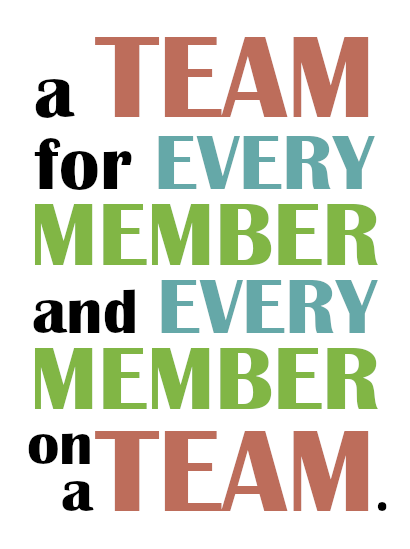 Frankly, if no one wants to participate in a particular ministry, then why are we wasting precious energy trying to make it happen? Now there are some ministries that we simply must do, like taking care of our buildings, managing our assets, and overseeing our personnel. But there are many legacy ministries that just stick around churches either because we have always done that or because someone else thinks it’s important. But if someone thinks is important, then they ought to care enough to help out and make it happen!
Frankly, if no one wants to participate in a particular ministry, then why are we wasting precious energy trying to make it happen? Now there are some ministries that we simply must do, like taking care of our buildings, managing our assets, and overseeing our personnel. But there are many legacy ministries that just stick around churches either because we have always done that or because someone else thinks it’s important. But if someone thinks is important, then they ought to care enough to help out and make it happen!
So the big trick becomes discovering the passions within our membership, identifying the needs of our community, and empowering people to bring these two items together.
This is why I have come up with the slogan: A team for every member and every member on a team.
This is heart of the new structure. In the past teams have been hard to fill because they required people to make a three year commitment, attend monthly meetings, and engage in projects they may not care about. In contrast, most true ministry teams are narrowly focused, meet as they need to, and are inspired by people’s interests.
Here is a chart of all the different teams we expect to start off with categorized according to our mission statement (which is also reflected in the new structure):
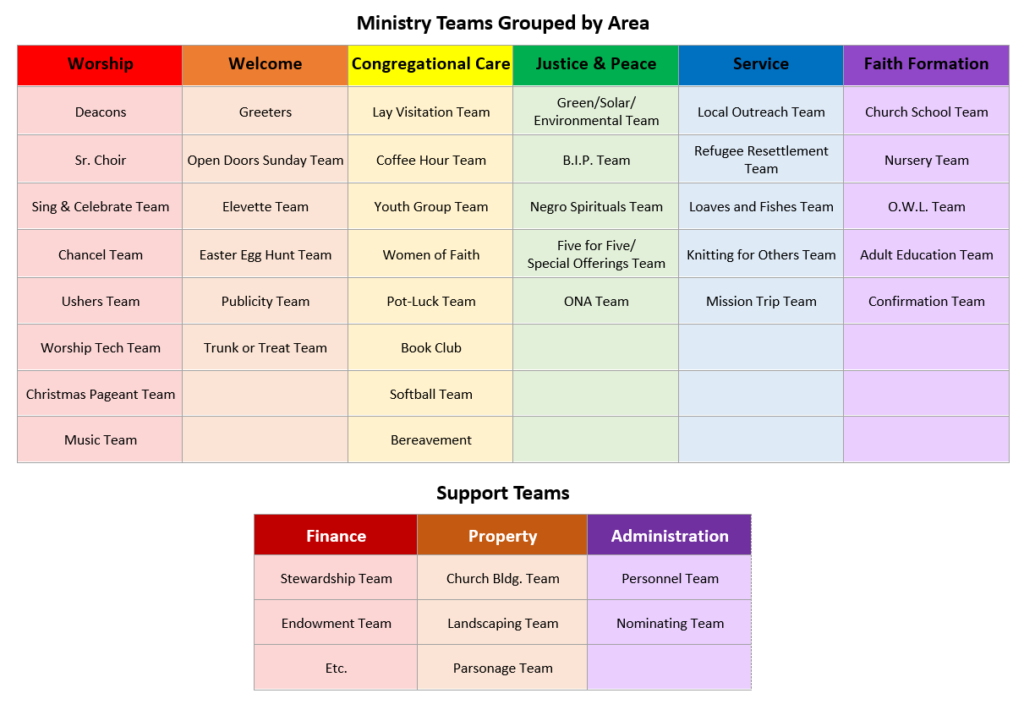
(Click here to enlarge)
And this is just the start! New teams can be formed at any time. We have a process in place that can help anyone in the church start up a new ministry if they feel called.
My hope is that every member of the church will be a part of a team. With so many ministries to choose from and so many of them tailored to particular interests, I hope everyone can find a team that speaks to them, fits within their unique schedule, and makes a difference in the church, community, or world. Wouldn’t that be amazing?!?
 Eventually, hopefully pretty soon, we will have all of these teams listed on the website with information about them and contact information on how to join or help out. That will be a bit of an undertaking to make happen, but it will happen. In the meantime, if you are interested in a team and do not know who to contact you can call the church and someone in the office will be able to point you in the right direction, myself included.
Eventually, hopefully pretty soon, we will have all of these teams listed on the website with information about them and contact information on how to join or help out. That will be a bit of an undertaking to make happen, but it will happen. In the meantime, if you are interested in a team and do not know who to contact you can call the church and someone in the office will be able to point you in the right direction, myself included.
Teams are the heart and soul of the planned new structure. They are the membership of the church. They are where the ministry happens. They are how people get involved and where real change happens. And they cannot exist without you. What would you like to get involved in? How would you like to be a meaningful part of your church? Once you find the answer, let’s talk and we’ll get you involved!


